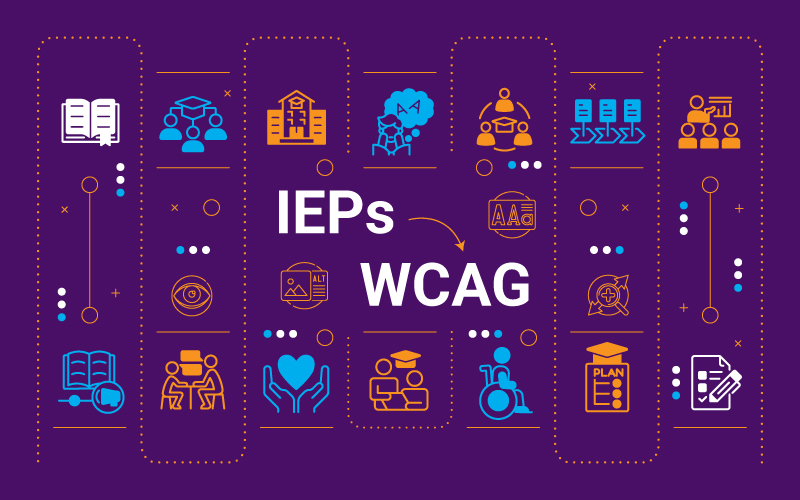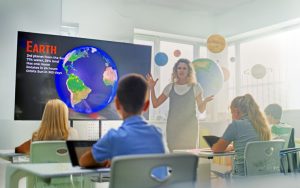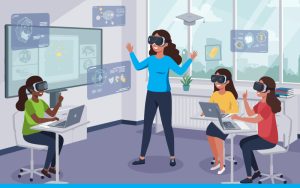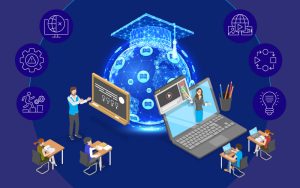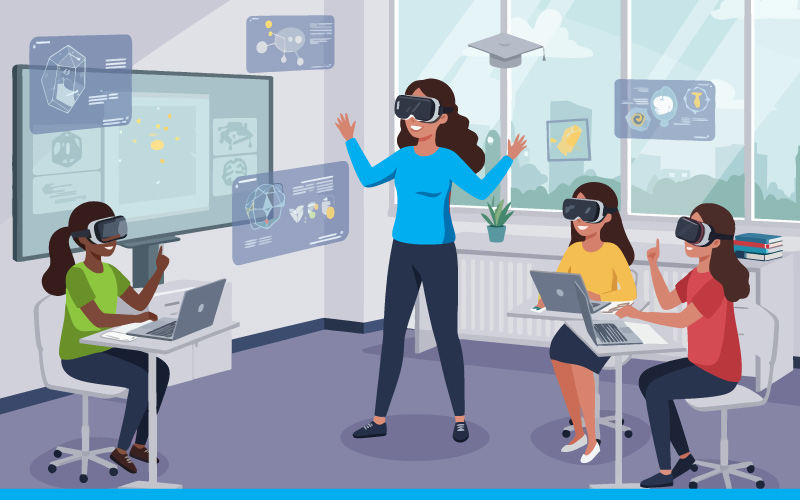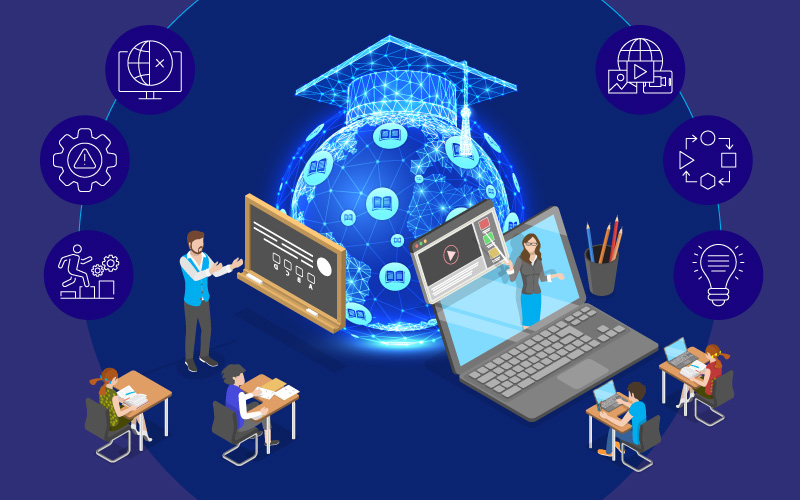In order to achieve inclusive digital learning, strong online accessibility standards must be combined with a student’s IEP (individualized education program) requirements. In the real world, this entails translating IEP-specified accommodations—such as specialized input devices, bigger text, audio aids, or additional time—into tangible, WCAG-aligned solutions.
The Web Content Accessibility Guidelines, or WCAG, offer an operational framework (Perceivable, Operable, Understandable, Robust) that guarantees all students, regardless of their different physical and learning requirements, have fair access to online resources. Instead of making modifications on the fly, schools can proactively create material that complies with WCAG 2.1 Level AA, the generally accepted legal level, which naturally supports a lot of IEP objectives. This entails including features like keyboard navigation, understandable layouts, subtitles, and adjustable timing into the eLearning content itself, rather than adding them later.
Digital inclusion is essential for modern education. As one toolkit notes, “accessible materials – technology – learner technology skills” form a critical chain linking the student to the curriculum. An IEP is strongest when every link in that chain is addressed: it should note not just what services a student needs, but how digital content will be delivered in accessible formats. For example, IEP teams are encouraged to explicitly ask whether a student “requires one or more specialized formats – braille, large print, audio, and/or digital text” of materials. Or, to put it another way, the IEP should highlight the need for accessible educational materials (AEM). The IEP should thereafter specify how such AEMs (such as alternative input devices, bigger print, or text-to-speech) would assist the student in achieving their learning objectives. In the real world, this could entail including objectives such as “teacher will provide accessible PDFs with proper alt text” or “student will use text-to-speech software during reading assignments.” It also means ensuring staff know how to prepare or procure accessible content.
Digital accommodations can span every part of the classroom experience. The American Foundation for the Blind advises IEP teams to include digital access throughout the IEP: from the present level statements (noting which tech tools already work or cause frustration) to annual goals and accommodations. For example, goals might specify which assistive technology (AT) is taught; accommodations might specify that screen-reader–friendly formats be provided in advance and that backup devices be ready. Teams should “align accommodations during instruction, assessment, and across school environments,” including virtual learning. As [AFB] notes, this could include ensuring online grade portals, school emails, or even cafeteria kiosks are accessible so a blind or low-vision student has the same information as peers. Ultimately, every accommodation written into an IEP (extra time, oral test, etc.) should have a clear digital counterpart built into the technology and content design.
The WCAG Framework for Inclusive Education
WCAG guidelines map neatly onto many IEP accommodations. These standards are increasingly mandated worldwide: for example, U.S. public schools must meet the new DOJ rule requiring WCAG 2.1 AA on all digital learning tools; similarly, the EU Web Accessibility Directive and UK regulations require WCAG 2.1/2.2 AA compliance for educational content.
The WCAG standards are either legally binding or de facto norms in other regions as well (UAE, India, Japan, Australia, etc.). To put it briefly, WCAG AA is the international standard for accessible educational materials, guaranteeing adherence to regulations such as the Equality Act, Section 504/508, the ADA, and others.
WCAG is organized around four pillars (Perceivable, Operable, Understandable, Robust) that correspond to concrete digital accommodations.
These complement educational approaches like Universal Design for Learning (UDL).
For example, pupils with reading problems or mobility challenges are directly supported by WCAG’s requirements for keyboard-friendly navigation (2.1.1), strong color contrast (1.4.3), and flexible font size (1.4.4). In practice, this means providing users the ability to switch to high contrast mode or magnify text by up to 200%. Additionally, it means making sure that content may be accessed solely through the keyboard, which will help people who use other input methods.
Across all WCAG pillars, educators should translate IEP accommodations into design features. For example, an IEP might call for “text-to-speech and reduced visual stress”.
Perceivable features would include alt-text and descriptions for all images and infographics (WCAG 1.1.1), video captions and transcripts for audio content (WCAG 1.2.2/1.2.4), and customizable text contrast or background colors for easier reading.
Operability means all interactions (buttons, quizzes, menus) work via keyboard or switch devices (WCAG 2.1.1) and that focus indicators are visible (2.4.7) so students using only keyboards can track their position. It also implies giving extra time on online assessments (WCAG 2.2.1) by allowing timers to be paused or extended, matching an IEP goal of extra time.
Understandability calls for clear page structure and language: use consistent navigation (3.2.3), plain age-appropriate text (3.1.5), and helpful error suggestions (3.3.3) so students aren’t confused by complex terminology or unclear instructions. For example, use short sentences or provide glossaries for new terms when needed.
Perceivable Accommodations
Make content perceivable for all senses. Every chart, infographic, or picture used in a lecture needs an extensive description or descriptive alt text. For audio and video, offer synchronized captions for previously recorded material (WCAG 1.2.2) and, if possible, live captioning for lectures that are being given in real time. Make lecture and readings transcripts available to students in Braille or through screen readers. Where a learning objective relies on visual information (like a science diagram), add an audio description track.
Allow audio versions of texts for students who struggle with reading (such as those with dyslexia) or make sure that screen readers and text-to-speech applications are compatible. Colors and fonts are also important: Arial, Verdana, and OpenDyslexic are dyslexia-friendly fonts to use. Avoid high glare by using soft pastels instead of white backgrounds. To sum it up simply, make sure that there are several ways to present information: text may be read aloud, and graphics can be interpreted by touch or sound (Braille), meeting WCAG’s perceivable goal.
Operable Accommodations
Make that all students, regardless of their physical capabilities, can navigate and engage with the curriculum. According to WCAG 2.1.1, all interactive components, including buttons, links, form fields, and video controls, must be accessible and usable with just a keyboard. This matches IEP needs like alternative input or limited fine motor skills.
Visible focus indicators (2.4.7) help these students track where they are on a page. Arrange pages with “skip to main content” links and logical heading order so screen-reader users can jump past menus (WCAG 2.4.1/2.4.6).
On touch devices (tablets, Chromebooks commonly used in K-12), make controls large enough (at least 44×44 px) and well-spaced to avoid accidental taps (WCAG 2.5.1/2.5.2).
If an IEP grants “extra time” on tests, translate that into flexible timing controls: allow quizzes to be paused or revisit questions without penalty (WCAG 2.2.1).
Ensure that learning games or simulations support alternative modes (e.g. voice commands or eye-gaze) as needed.
Above all, maintain predictable and consistent page structure so students aren’t “lost” – all pages should follow the same menu, layout, and button-label conventions.
Understandable Content
For pupils with attention or learning disabilities, clarity is essential. Use straightforward language and a clear layout in accordance with WCAG’s Understandable criteria. For instance, use standardized fonts and headers, define new terminology consistently, and divide material into brief paragraphs and bullet lists. Simplified instructions or “check understanding” prompts are common IEP adaptations; incorporate these elements into your digital design (e.g., tooltips or pop-up glossaries for jargon). Consistent navigation labels and menu positions also reduce confusion. Provide clear error messages and suggestions so students can recover if they make a mistake (e.g. “Please enter a number” when they type a word into a math field). These measures help fulfill goals in IEPs like “improved comprehension” and “independent task management”. Accessibility experts note that inclusive design (clear headings, intuitive layout, multiple formats) not only assists specific learners but benefits all students.
Robust and Future-Proof
Last but not least, confirm that the material is compatible with various browsers, devices, and assistive technologies. To ensure that headings, tables, and controls are correctly interpreted by screen readers, use semantic HTML/ARIA roles. Test material on PCs and mobile devices using popular assistive technology (NVDA, VoiceOver). Use web-standard libraries that adhere to ARIA principles rather than proprietary widgets. Ensure that documents and PDFs are appropriately marked (e.g., with heading structure and text equivalents). This flexibility guarantees that the information will be suitable when an IEP specifies a required tool (such as a particular screen reader or refreshable Braille device).
Tools, Strategies, and Collaboration
Translating IEPs to digital accommodations is a team effort. It often involves special educators, general teachers, curriculum designers, IT staff, and parents. Collaboration is essential. For instance, co-planning sessions can decide who will create alt-text, who will check color contrast, and who will train students on assistive tools. Training educators is critical – professional development on UDL and WCAG gives teachers the skills to build accessible lessons. Classroom technology (LMS, authoring tools, video platforms) should be chosen with accessibility in mind. District procurement policies should explicitly require WCAG compliance in RFPs and contracts. In practice, this means school districts include clauses that any third-party content (digital textbooks, educational apps, media) meet at least WCAG AA. This aligns with new laws (e.g. Illinois HB 26) demanding WCAG adherence in K–12 materials.
Tools can streamline accommodations. Accessibility checks and integrations (such as read-aloud plugins and captioning) are included into several learning management system (LMS) platforms, such as Canvas and Google Classroom. Both free and paid resources can be used, including arithmetic accessibility tools, speech-to-text/voice recognition (for students who type slowly), screen readers, and annotating software. Students can directly address demands like visual stress by modifying fonts, colors, and spacing on any website using accessibility toolbars (like Recite Me). The establishment of an Accessible Educational Materials (AEM) repository, which is a bank of textbooks and resources in various formats (large-print, braille, audio, and digital text), should also be a priority for districts. This repository should be cited in the IEP so that teachers are aware of where to find resources and how to adapt them.
Regular audits and checklists keep practices on track. Schools can follow a step-by-step WCAG audit (see Step-by-Step WCAG Audits for Existing eLearning Content) to identify gaps: each identified accommodation (like “provide captions” or “ensure keyboard-only operation”) becomes a to-do item. Automated tools scan for missing alt text or bad contrast, but manual reviews catch most issues (one study found 84% of accessibility issues are human-only discoveries). Involving students in user testing also helps: a student who needs extra time on an IEP can help test whether an online quiz can be paused. Every improvement should be documented (with screenshots or VPAT reports) to show compliance and inform future IEP teams.
Examples and Best Practices
Consider some scenarios and how to address them:
- A pupil experiences reading issues similar to dyslexia. Offer resources in a variety of formats, including readable fonts (like Arial or OpenDyslexic) and customizable color schemes. Ensure all text content has audio versions or text-to-speech support. Break information into short sentences and use bullet lists. Allow more time on reading tasks (WCAG 2.2.1 flexibility) and use “chunking” of content. Use videos with synchronized captions (beneficial for ELL and hard-of-hearing as well). Altogether, this aligns with an IEP goal of improving reading comprehension.
- A pupil is hard of hearing or deaf. According to WCAG 1.2.2, all spoken instructions and media should contain transcripts or captions. Provide visual signals in place of auditory ones, such as a visual alert when the quiz timer is about to expire. Make sure there is live captioning or an interpreter during Zoom or Teams live sessions (and add captions retroactively to recorded sessions). Use shared digital whiteboards or text chat for group projects so that all students can contribute fully. These measures fulfill IEP accommodations like “access to lecture content” or “preferential seating” in a visual format.
- A student has motor challenges (e.g. limited hand control). Enable full keyboard navigation (WCAG 2.1.1) so they can use a switch or voice recognition. Build in ample time on tests. Make sure clickable areas are large (WCAG 2.5.1), and allow alternate input (voice typing for essays, for instance). Provide an onscreen keyboard or stylus support if needed. These features meet IEP goals such as “use assistive devices” and “reduce fine motor demand.”
- Cognitive/attention difficulties. Design pages to be uncluttered and consistent. Steer clear of sudden pop-ups and flashing animations. Make use of a consistent layout and clear headings (WCAG 3.2.3). Utilize checklists and divide activities into manageable chunks. To emphasize important points, use summaries or visual diagrams. To maintain focus, give practice tests with instant feedback (WCAG 3.3.3). This helps achieve IEP goals like “reduce frustration” and “improve task focus.”
These examples illustrate the general principle: every IEP accommodation should correspond to a WCAG-savvy design practice. A table of common IEP accommodations vs. digital strategies might look like:
scroll right to read more
| IEP Accommodation | Digital/WCAG-Compliant Strategy |
|---|---|
| Audio support (text-to-speech) | Provide transcripts and screen-reader–friendly HTML (WCAG 1.1.1, 1.2.5) |
| Enlarged text or high contrast | Enable 200% text zoom (1.4.4); use high color contrast (4.5:1, 1.4.3) and dark/light mode toggles |
| Keyboard access or motor aid | Ensure full keyboard navigation (2.1.1) and voice-input options; large clickable areas (2.5.1) |
| Extra time on tasks | Allow extending/pausing timers (2.2.1) and self-paced modules |
| Captions/transcripts for hearing needs | Caption all videos (1.2.2); provide written notes for audio content |
| Complex visual info | Use simplified diagrams and provide text descriptions (1.1.1); interactive charts with audio cues |
| Distractibility/consistency | Use clear, consistent layouts (3.2.3); limit distracting motion (2.3.1) or allow it to be stopped (2.2.2); minimal pop-ups |
| Math/Science symbols (blindness) | Use MathML or alt-text for equations (1.1.1) and tactile graphics if needed |
| Language or reading difficulties | Plain language (3.1.5) and vocabulary definitions (tooltips/glossary) |
These strategies not only satisfy legal requirements but also embody universal design: they help all learners. For instance, captions aid second-language learners; large text benefits aging teachers and students with temporary vision issues; clear navigation helps everyone learn more efficiently.
Regional Standards and Legal Context
Additionally, it’s critical to keep in mind the local laws. The ADA, Section 504, and IDEA in the US mandate that online education be just as accessible as traditional classroom instruction. Recent federal rules explicitly cite WCAG AA as the benchmark for educational technology. State laws (like Illinois HB 26 or California’s AB 434) go further, mandating that all K–12 digital materials meet WCAG AA. The UK’s Equality Act and Web Accessibility Regs require public schools’ content to comply (often phrased as “reasonable adjustments” for disabled students). The EU’s Web Accessibility Directive similarly mandates WCAG AA for educational websites and eLearning platforms mitrmedia.com. Many governments in the Middle East and Asia-Pacific make reference to WCAG in their accessibility regulations; for instance, UAE law mandates that government websites adhere to WCAG 2.1 AA.
On a practical level, the district is protected both legally and educationally when IEPs are in line with WCAG compliance. In addition to the school’s WCAG rules and audits as proof of implementation, legal teams and special education departments can use kids’ IEPs as proof that the district made plans for digital access.
Many experts advise treating WCAG as non-negotiable in any vendor contract or curriculum adoption process.
In fact, districts are encouraged under the coSN accessibility framework to collaborate with assistive technology experts during the procurement process and incorporate accessible standards into RFPs and adoption guidelines, and to partner with assistive technology specialists during procurement. This guarantees that, for example, online exercises provided by a math software vendor will already have keyboard navigation, alt-text, and captioned videos.
Conclusion
Converting IEPs into digital accommodations that comply with WCAG is a continuous process rather than a one-time event. It blends inclusive design, pedagogical planning, and legal compliance. Using WCAG as a guide, teachers can methodically translate each IEP goal into a particular feature or procedure in their digital content, such as an extended timer on a quiz, a caption for a video, alt text for an image, or a distinct heading structure. As a result, no student is left behind in the classroom due to the way the material is delivered online.
The entire school community gains when educators and technology collaborate under this paradigm. In addition to helping students with temporary disabilities and English language learners, accessible design typically improves the clarity and adaptability of instruction.
Studies show that when content is made perceivable and operable for all, engagement and outcomes improve across the board. This inclusive approach is truly a “win-win” – it fulfills each student’s IEP while simultaneously creating a richer, more effective learning experience for everyone.
References: See Demystifying Legal WCAG Compliance for K–12 Schools and Step-by-Step WCAG Audits for Existing eLearning Content for guides on implementing these practices. Educational accessibility toolkits and AEM resources (CAST) provide practical IEP templates and examples, while organizations like CoSN and W3C offer standards and checklists to keep your digital classrooms on track. By following WCAG-aligned best practices, schools can truly fulfill the promise of equity embedded in every IEP.


